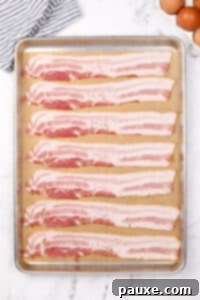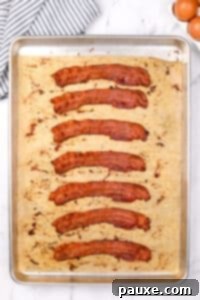Say goodbye to greasy stovetop splatters and unevenly cooked strips! This ultimate, easy method for making Crispy Oven Baked Bacon is a total game-changer, promising perfect results every single time. Not only is it incredibly mess-free, yielding deliciously crispy slices with minimal fuss, but it also frees up your hands and stovetop for other essential kitchen tasks, like whipping up fluffy scrambled eggs or toasting artisan bread to perfection.
Whether you’re preparing a hearty family breakfast, hosting a big brunch gathering, or simply batch cooking a large quantity of bacon for convenient meal prep throughout the week, baking bacon in the oven is by far the most efficient and superior approach.
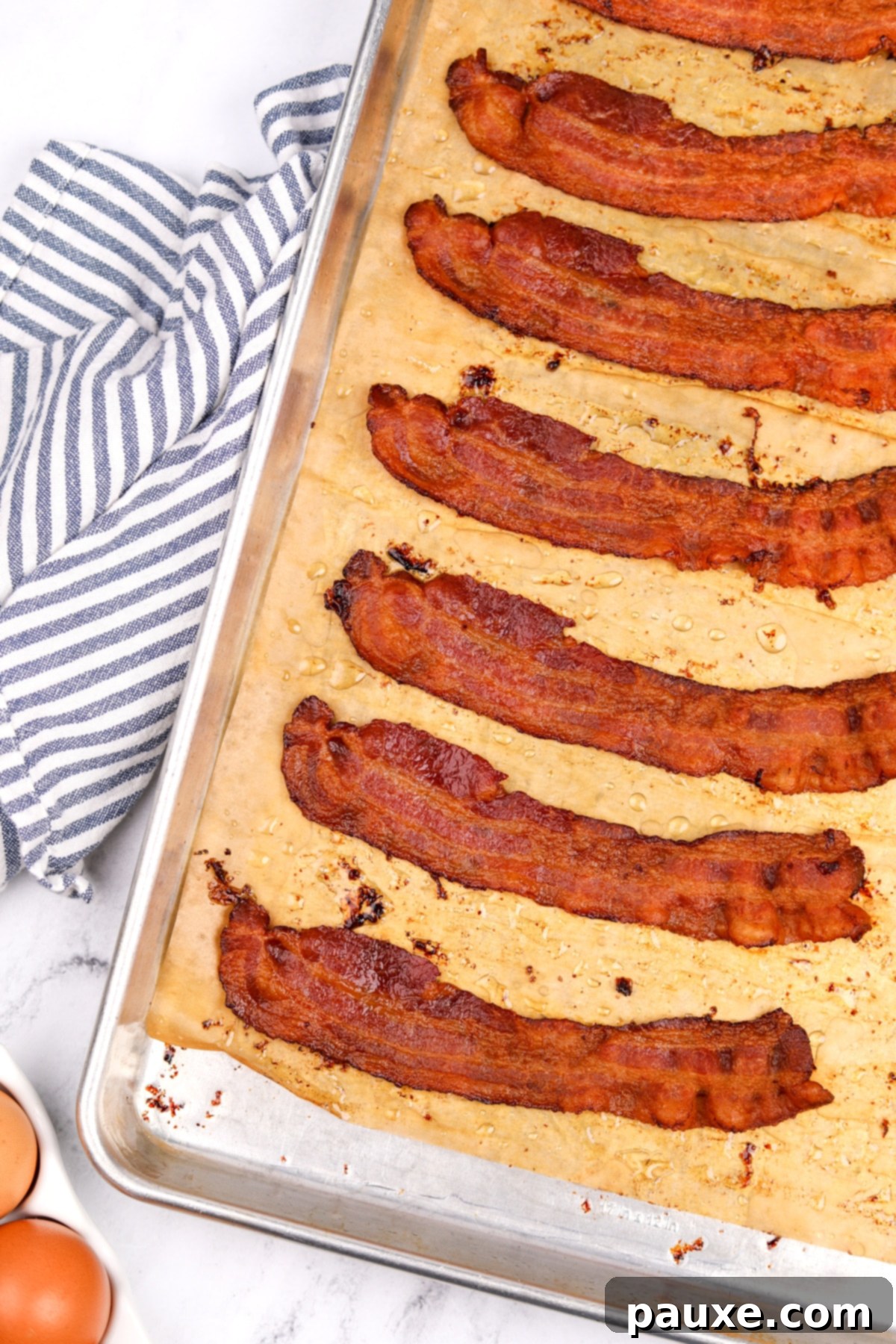
Having experimented with countless methods for cooking bacon over the years, from sizzling in a cast-iron skillet to air frying, I can confidently say that oven-baked bacon stands out as my absolute favorite. If you haven’t yet embraced this revolutionary technique, you’re missing out on an absolute culinary revelation!
Beyond the undeniable convenience, the oven method dramatically reduces, if not completely eliminates, troublesome grease splatter, keeping your kitchen cleaner. More importantly, it consistently produces the most flavorful, uniformly crispy bacon you’ll ever taste. There’s no constant flipping, no babysitting the pan – just consistently perfect bacon that cooks itself while you focus on other things.
Why You’ll Fall in Love with Oven Baked Bacon:
- Consistently Perfect Crispiness: The even, radiant heat of the oven ensures that every single strip of bacon cooks uniformly, achieving that ideal level of crispiness without any burnt edges or soggy spots. You’ll get perfectly golden-brown, shatteringly crisp bacon from end to end, every single time.
- Effortless Cleanup: Bid farewell to tedious scrubbing! Compared to the traditional stovetop method, which often leaves grease splattered across your backsplash and countertops, this sheet pan technique is remarkably clean. Lining your baking sheet with parchment paper or foil means virtually no grease splatter and a quick, easy disposal of fat and paper.
- Ideal for Batch Cooking & Meal Prep: Whether you’ve stocked up on bacon during a sale or you’re planning ahead for busy mornings, the oven method is unparalleled for cooking large quantities efficiently. You can easily cook one or two pounds of bacon (or more, in batches) at once, making it perfect for feeding a crowd or preparing delicious additions to meals throughout the week.
- Budget-Friendly & Time-Saving: Many busy home cooks resort to purchasing pre-cooked or frozen bacon for convenience, which often comes with a hefty price tag. By baking your own bacon in bulk and freezing it, you save money without sacrificing convenience. You’ll have delicious, homemade crispy bacon ready to reheat whenever you need it.
- Hands-Off Cooking: This is perhaps the biggest perk. Once the bacon is in the oven, your work is largely done until it’s time to flip. No more standing over a hot stove, constantly monitoring and flipping individual slices. This hands-off approach allows you to multitask, prepare other breakfast items, or simply relax.
Simple Ingredients for Perfect Crispy Bacon
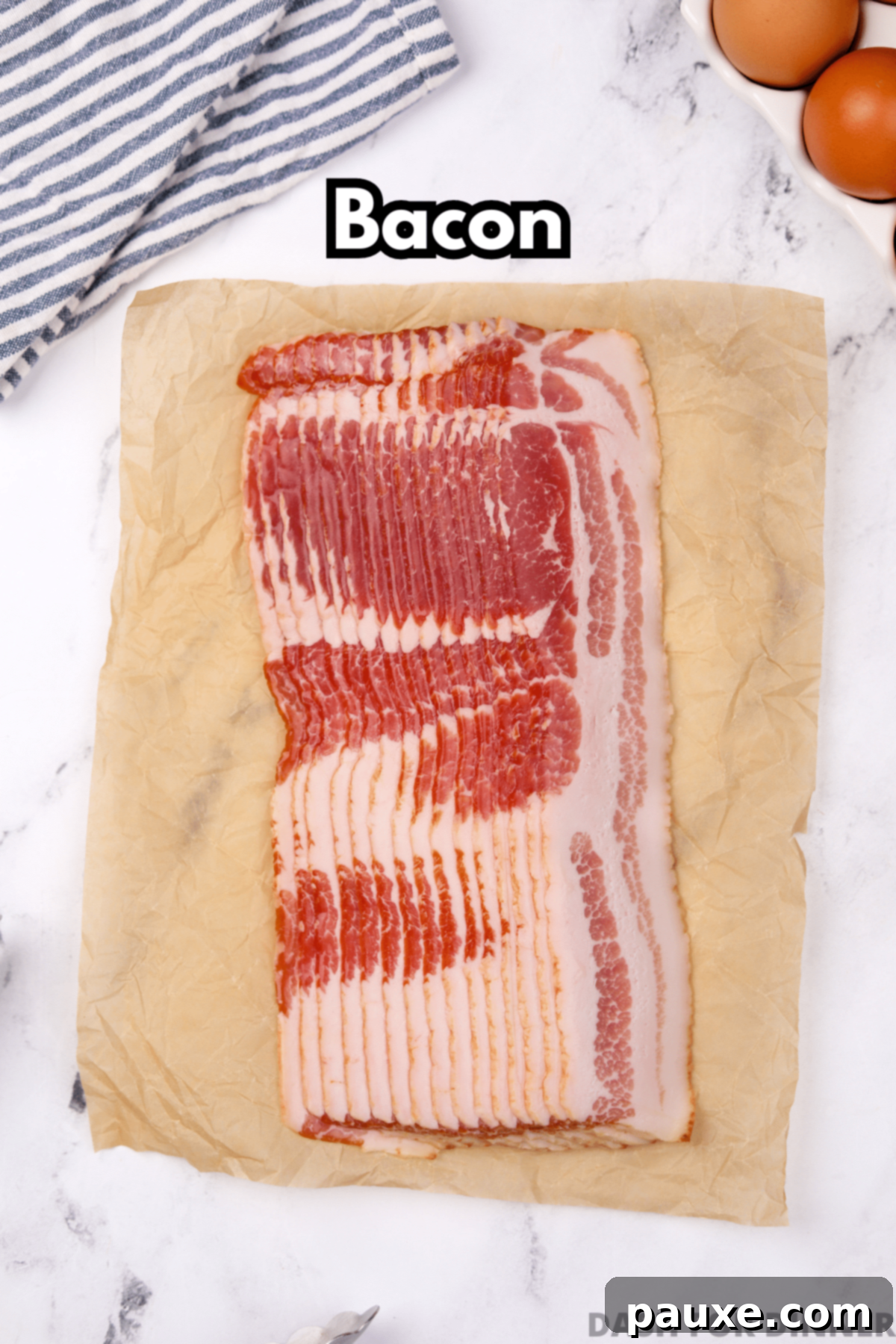
- Bacon: The star of the show! You can prepare almost any quantity of bacon using this method; simply adjust the number of baking sheets or work in batches. I typically bake 1-2 pounds of standard-cut bacon at a time. While regular cut is recommended for the stated cooking times, feel free to use thick-cut bacon, keeping in mind it will require a slightly longer baking time to reach optimal crispiness. Thin-cut bacon will cook faster. For best results, choose a good quality bacon without excessive sugar content, as high sugar can lead to quicker burning.
Essential Equipment for Mess-Free Bacon
- Rimmed Baking Sheet: A crucial piece of equipment! You’ll need a sturdy baking pan with raised edges to effectively contain the rendering bacon grease, preventing spills and keeping your oven clean. A standard half-sheet pan, readily available at any department or kitchen supply store, is perfectly sized for about 8-12 slices of bacon.
- Parchment Paper or Aluminum Foil: This is your secret weapon for super easy cleanup. Lining the baking sheet with parchment paper prevents the bacon from sticking and makes disposing of the accumulated grease incredibly simple. Alternatively, heavy-duty aluminum foil can be used, though parchment paper often offers slightly better non-stick properties and a tidier grease containment.
- Tongs: Essential for safely flipping the bacon halfway through cooking and transferring the hot, crispy strips to a draining plate without burning your fingers.
- Paper Towels or Cooling Rack: For draining excess fat and achieving maximum crispiness after baking.
Mastering Crispy Bacon in the Oven: Step-by-Step Guide
Achieving perfectly crispy, evenly cooked bacon in the oven is simpler than you might think. Follow these easy steps for flawless results every time:
Step One: Prepare Your Oven and Pan. Preheat your oven to 425ºF (218ºC). This high temperature is key to achieving that desirable crispiness. While the oven preheats, line a rimmed baking sheet with either parchment paper or aluminum foil. Ensure the lining extends up the sides of the pan slightly to contain any grease.
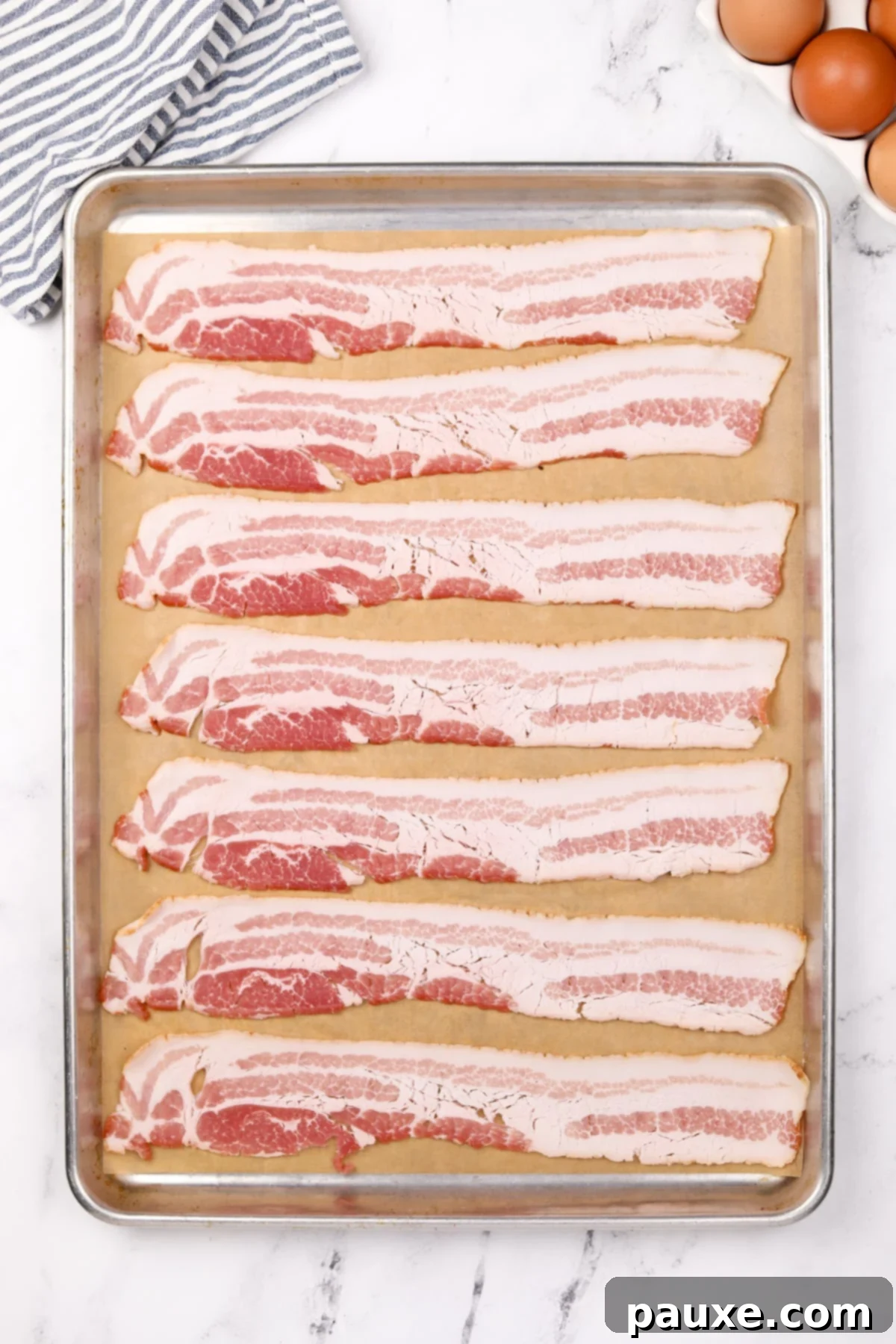
Step Two: Arrange the Bacon. Lay out 7-8 strips of bacon in a single layer on the prepared baking sheet. It’s crucial to ensure that none of the bacon strips overlap. This meticulous spacing is vital, as it allows for even airflow and consistent cooking, preventing the bacon from steaming and ensuring each piece gets beautifully crisp. Overlapping pieces will stick together and cook unevenly.
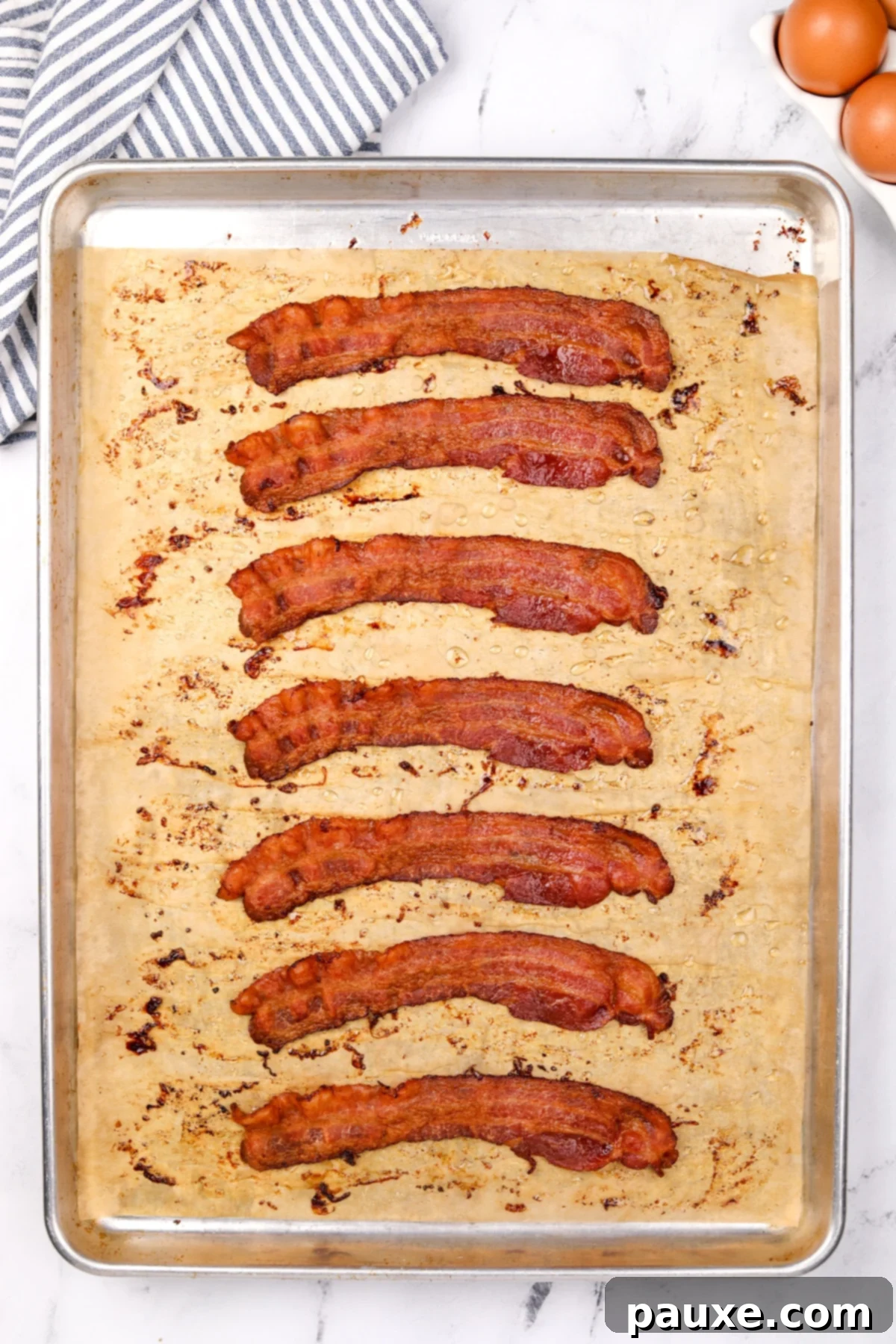
Step Three: Bake and Flip. Place the baking sheet in the preheated 425ºF (218ºC) oven and bake for 16-22 minutes. For optimal crispiness and even browning, carefully flip each piece of bacon halfway through the cooking time, typically around the 10-minute mark. Monitor the bacon closely during the final minutes, as cooking times can vary slightly depending on your oven and desired crispiness. Remove the baking sheet from the oven as soon as the bacon reaches your preferred level of doneness—from chewy to shatteringly crisp.
Perfect Draining for Ultimate Crispiness
Draining off excess grease is a simple yet crucial step to ensure your bacon achieves its maximum crispiness and avoids any oiliness. This process allows the residual fat to be absorbed, enhancing the texture and making for a more enjoyable bite.
- Prepare a plate by lining it with a double layer of paper towels. The paper towels will absorb the rendered fat.
- Using tongs, carefully transfer the hot, cooked bacon pieces from the baking sheet to the paper towel-lined plate.
- Allow the bacon to rest and drain for a few minutes before serving. This brief resting period is essential for absorbing any surface grease and allowing the bacon to crisp up further as it cools slightly.
- Alternatively, for even crispier results, you can transfer the bacon to a wire cooling rack placed over a clean baking sheet. This allows air to circulate around all sides of the bacon as it cools, preventing it from sitting in its own grease.
Understanding Bacon Thickness and Adjusting Cooking Time
The thickness of your bacon strips is a significant factor in determining the overall cooking time required to achieve that perfect crispy texture. Different cuts demand slight adjustments to ensure optimal results without overcooking or leaving them underdone.
- Thick-Cut Bacon: If you prefer the hearty chew and robust flavor of thick-cut bacon, you’ll need to extend the baking time. Add approximately 2-4 minutes to the total baking time, so aim for 18-26 minutes, with a flip around 12-14 minutes. Watch closely as it approaches your desired crispiness.
- Regular Cut Bacon: For standard-cut bacon, follow the recipe as directed. The 16-22 minute range (with a flip at 10 minutes) should yield beautifully crispy results.
- Thin-Cut Bacon: Thinly sliced bacon cooks much faster. Reduce the total cooking time by about 2-4 minutes, aiming for 14-20 minutes, with a flip around 8-9 minutes. Be extra vigilant during the final minutes, as thin bacon can go from perfectly done to burnt very quickly.
For Less Crispy Bacon: If your preference leans towards a chewier, less brittle texture, keep a very close eye on your bacon. Remove it from the oven as soon as it reaches your desired doneness, likely in the 12-16 minute range for regular cut bacon, depending on your oven and personal preference. It will firm up slightly as it cools.
Chef’s Secrets for Flawless Oven Bacon
- Flip for Even Cooking and Browning: While not strictly mandatory, flipping your bacon halfway through the baking process is highly recommended. This ensures both sides of each strip brown evenly and promotes consistent crispiness throughout. It also helps render the fat more uniformly.
- Always Drain Rendered Fat Between Batches: If you’re cooking multiple batches of bacon, it’s absolutely crucial to carefully drain the rendered bacon fat from the pan in between each batch. Accumulated fat can cause subsequent batches to cook much faster and, more importantly, can start to smoke and burn, imparting an unpleasant, acrid flavor to your fresh bacon. Use caution when handling hot grease.
- Never Overcrowd the Pan: Patience is a virtue when baking bacon. It’s always better to work in smaller batches than to overcrowd your baking sheet. Overcrowding leads to more steam trapped in the oven, which hinders crisping, and causes bacon strips to overlap and stick together. For consistently crispy, separate slices, ensure ample space around each piece.
- Don’t Start in a Cold Oven: While some methods suggest starting bacon in a cold oven, our tests show that preheating to 425°F (218°C) delivers superior crispiness and more consistent results. The high initial heat helps sear the bacon quickly, leading to better texture. It also makes subsequent batches easier to time.
- Watch Closely, Especially Towards the End: Bacon can go from perfectly crispy to burnt in a matter of seconds. Keep a watchful eye on your bacon, particularly during the last 5-7 minutes of cooking. Bacon continues to crisp up slightly as it cools, so err on the side of removing it just before it looks fully done in the oven.
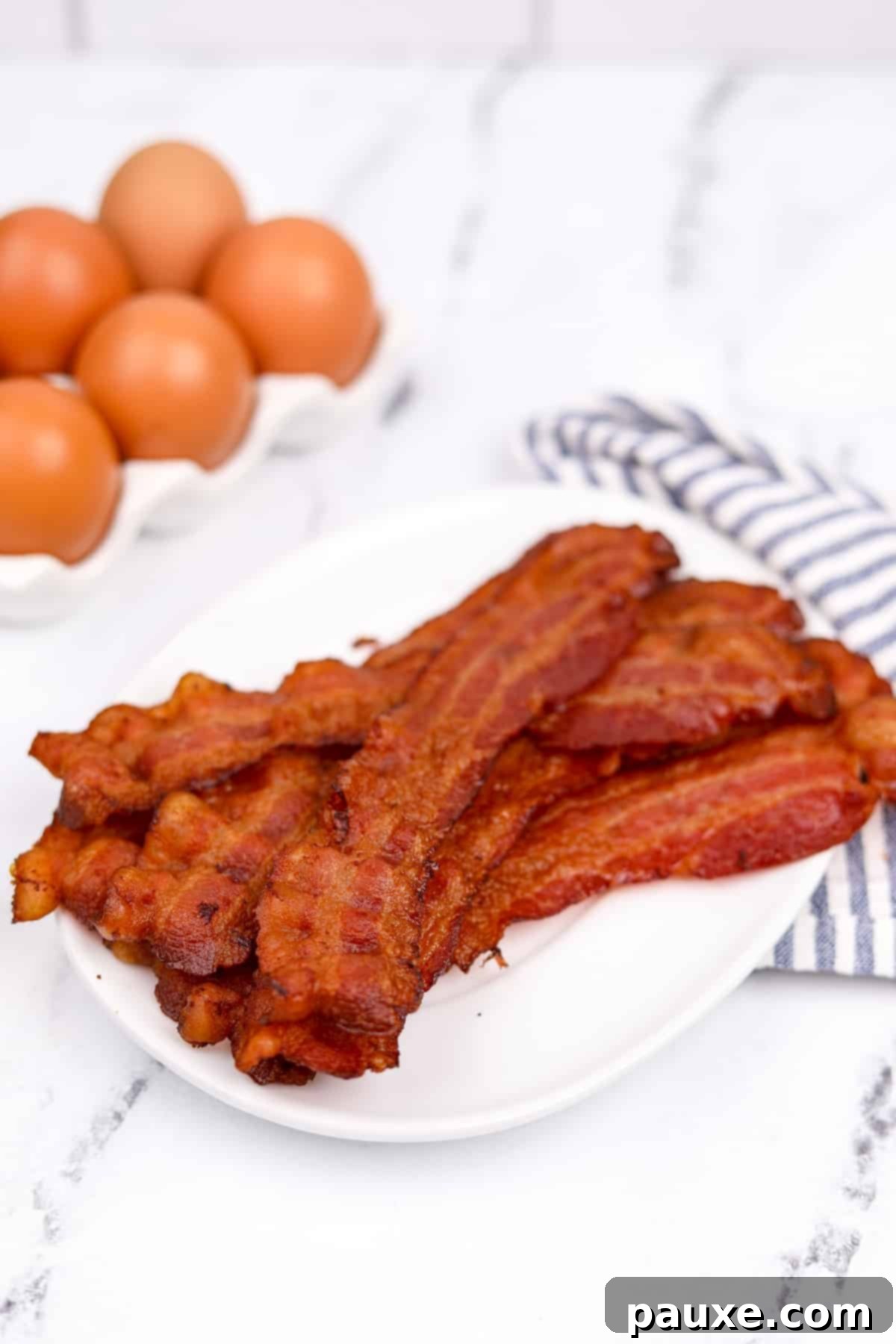
Storing and Reheating Your Crispy Bacon
Proper storage ensures your delicious oven-baked bacon stays fresh and flavorful for future enjoyment. Here’s how to store and reheat it:
- Refrigerator Storage: Once your bacon has completely cooled to room temperature, transfer the cooked pieces to an airtight container. Stored properly, oven-baked bacon will remain fresh and delicious in the refrigerator for 4-5 days. It’s perfect for quick additions to meals or last-minute snacking.
- Freezer Storage: For longer preservation, cooled bacon freezes beautifully. Arrange cooled strips in a single layer on a parchment-lined baking sheet and flash freeze for 30 minutes to an hour until firm. Then, transfer the frozen bacon to a heavy-duty freezer bag or airtight container. Remove as much excess air as possible before sealing. Label the bag with the date and contents. Frozen bacon can maintain its quality for 3-6 months.
- Re-crisping and Reheating: While you can eat cold bacon, for the best experience, re-crisping your prepared bacon is highly recommended. This brings back its delightful texture. After reheating, I like to drain the pieces on a fresh paper towel to remove any excess grease, which contributes to ultimate crispiness.
- Skillet: Heat a non-stick or cast-iron skillet over medium heat. Add the bacon and warm for 30-60 seconds per side, until heated through and re-crisped to your liking.
- Air Fryer: Place bacon in a single layer in the air fryer basket. Use the “reheat” setting or set to 350°F (175°C) and heat for 1-3 minutes, checking frequently.
- Microwave: For a quick reheat, place bacon on a paper towel-lined plate. Heat in 30-second intervals until warmed throughout. While convenient, this method may not achieve the same level of crispiness as a skillet or air fryer.
What to Do with Rendered Bacon Fat?
Don’t let that flavorful rendered bacon fat go to waste! It’s a culinary treasure that can elevate many dishes. For best results and to maintain a clean flavor, I highly recommend draining the bacon fat from your baking pan after each batch has come out of the oven, especially if you’re cooking multiple rounds. This prevents subsequent batches from overcooking in hot oil and avoids any burnt flavors.
The collected bacon grease can be transferred to a heat-safe glass jar or ceramic container and stored in the refrigerator for future use as a rich, savory cooking fat. Rendered bacon fat is incredibly versatile and commonly used for:
- Sautéing vegetables, especially collard greens, spinach, or kale.
- Greasing cast iron skillets for cooking eggs, pancakes, or cornbread.
- Making a flavorful roux for gravies or sauces.
- Adding depth to roasted potatoes or popcorn.
- Enhancing the flavor of cornbread or biscuits.
Top Tip for Storing Bacon Grease: To ensure your bacon grease keeps for an extended period and remains free of impurities, I recommend straining off any bacon solids. You can easily do this by pouring the warm (but not scalding hot) fat through a fine-mesh sieve lined with a coffee filter or cheesecloth into your storage jar. This removes any small burnt bits that could cause the fat to spoil faster. Stored properly in the refrigerator, strained bacon fat can last for several months.
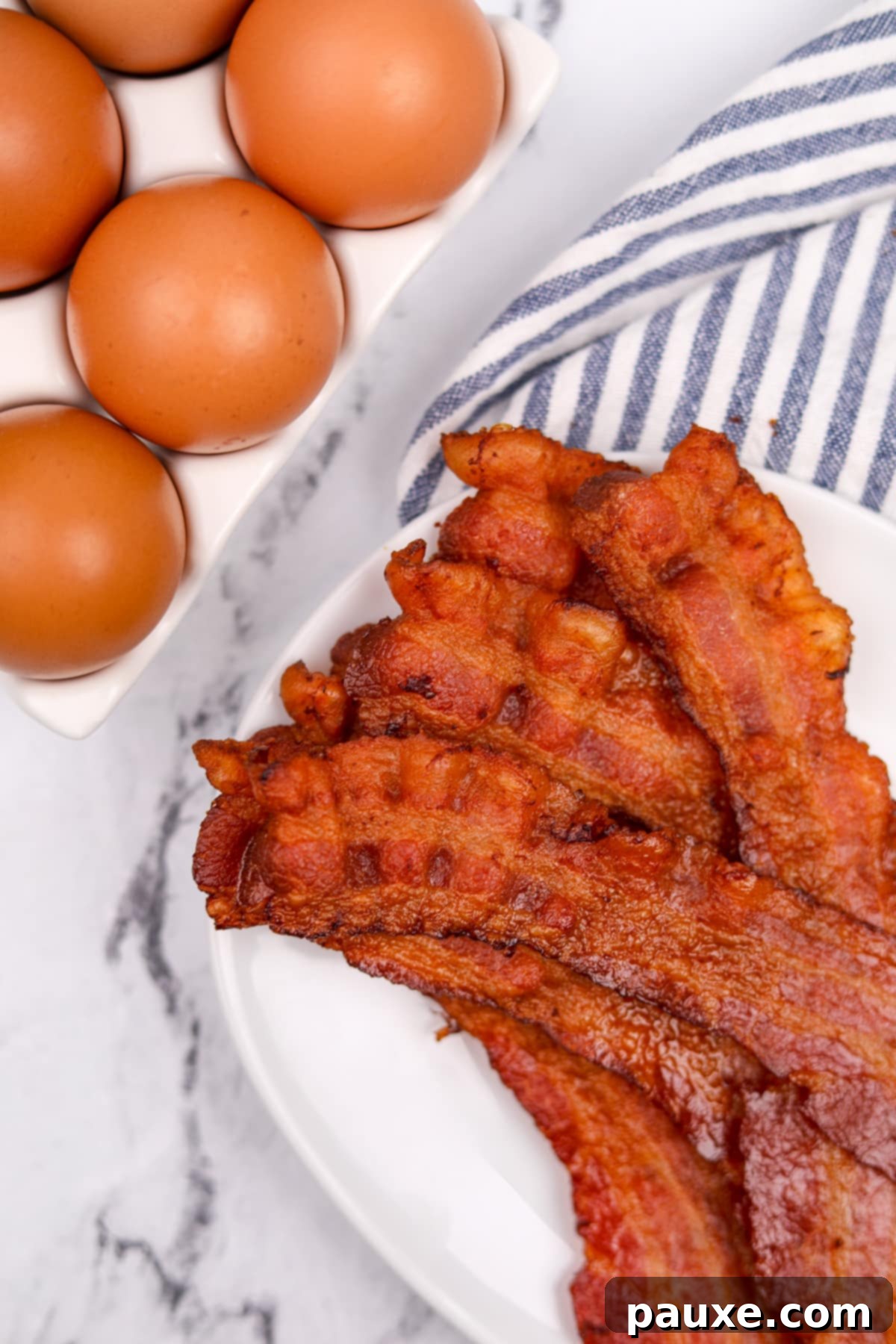
Delicious Ways to Utilize Your Crispy Oven Baked Bacon
Once you’ve mastered the art of crispy oven-baked bacon, the culinary possibilities are endless! Here are just a few ideas to inspire you:
- Classic BLT Sandwiches: The ultimate use! Layer with fresh lettuce and ripe tomatoes on toasted bread.
- Hearty Breakfast Sandwiches: Pair with eggs and cheese on a bagel, English muffin, or croissant.
- Loaded Baked Potatoes: Crumble over a hot baked potato with sour cream, chives, and cheese.
- Effortless Meal Prep: Have pre-cooked bacon ready for quick breakfasts, salads, or sandwiches throughout the week.
- Homemade Bacon Bits: Finely crumble for a crunchy topping on salads, soups, or casseroles.
- Added to Casseroles: Elevate the flavor profile of breakfast or dinner casseroles with savory bacon pieces.
- Creamy Dips: Stir into cheesy dips, like a loaded baked potato dip, for an irresistible smoky kick.
- Subs, Sandwiches, or Salads: A fantastic addition to almost any sandwich, wrap, or green salad for added texture and flavor.
- Simple Snacking: Enjoy as a protein-packed, crispy snack on its own.
- Traditional Breakfast Spreads: The perfect accompaniment to eggs, pancakes, waffles, or French toast.
- Frozen for Later Use: Always have a stash ready for unexpected cravings or recipes.
- Bacon-Wrapped Dishes: Use slightly less crispy bacon for wrapping around dates, scallops, or asparagus before a final bake.
- Garnishing Soups & Stews: A sprinkle of crispy bacon bits adds a gourmet touch to creamy soups.
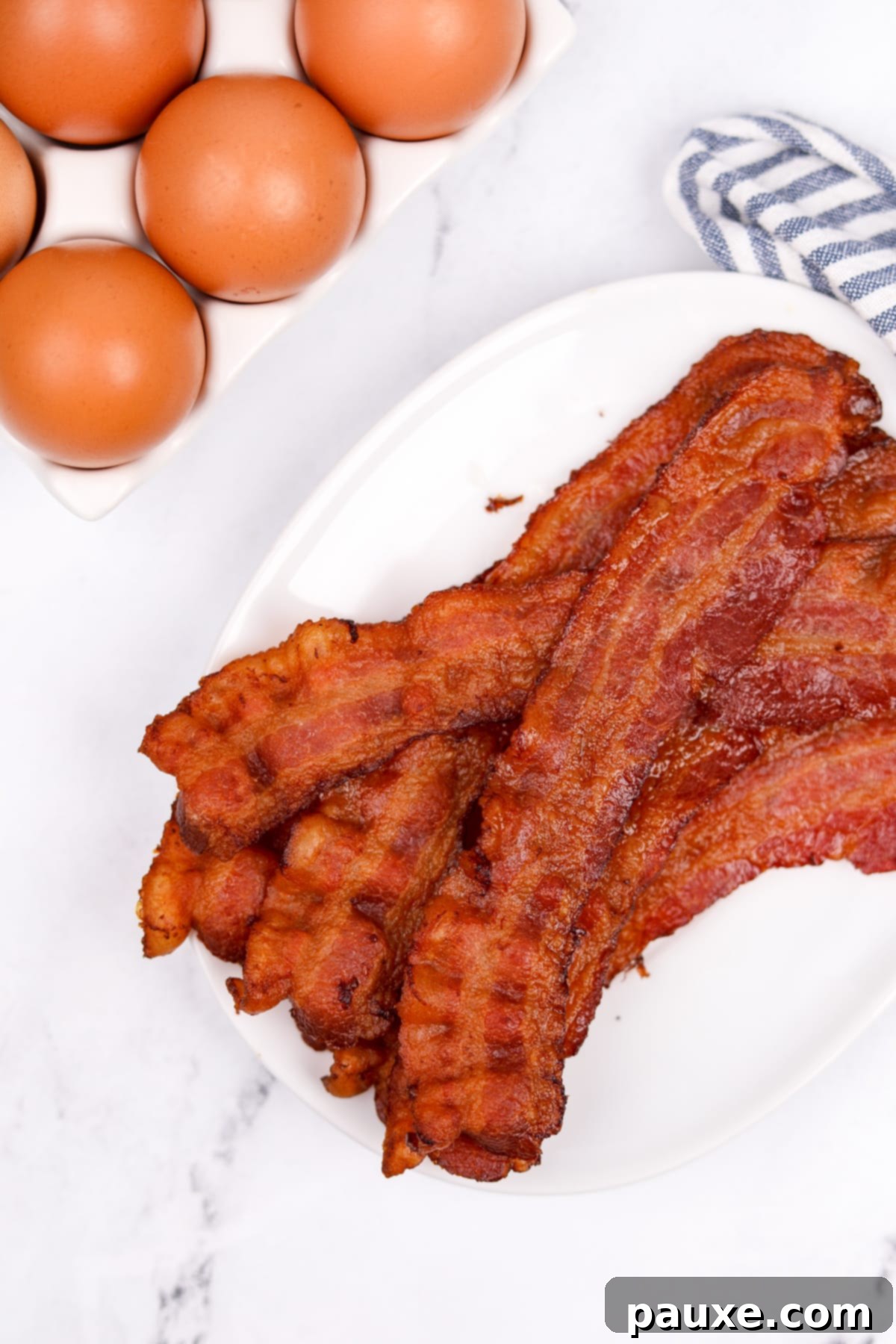
Frequently Asked Questions About Oven Baked Bacon
Should I start the bacon in a cold oven?
I’ve extensively tested this recipe using various methods, including starting bacon in a cold oven. While starting cold can work, I’ve found that preheating the oven to 425ºF (218ºC) delivers consistently crispier results with a more even cook. The majority of home cooks are accustomed to preheating their ovens, and this approach ensures clarity for subsequent batches, making the overall process more straightforward and reliable.
Should I use a cooling rack for baking bacon?
You can certainly use an oven-safe wire cooling rack placed over your rimmed baking sheet. This allows air to circulate completely around the bacon, potentially leading to slightly crispier results. However, my tests have shown that using parchment paper directly on the baking sheet delivers very similar levels of crispiness without the added difficulty of cleaning a greasy wire rack. For ease of cleanup, I typically recommend the parchment paper method.
Can I use aluminum foil instead of parchment paper?
Yes, absolutely! Aluminum foil is a perfectly acceptable alternative to parchment paper for lining your baking sheet. Both options provide an excellent non-stick surface and significantly aid in easy cleanup. Just make sure to use heavy-duty foil to prevent any tearing when draining the hot grease.
How do I know when the bacon is done?
Bacon is done when it reaches your desired level of crispiness and color. It should be golden brown and will appear slightly darker and firmer than when raw. Remember that bacon will continue to crisp up a little more as it cools, so it’s often best to remove it from the oven just before it looks “perfectly done” to avoid overcooking. Visual cues include reduced bubbling of fat and a more uniform, hardened texture.
Can I add seasoning to my bacon?
Absolutely! For a flavorful twist, you can sprinkle your bacon with a pinch of black pepper, a touch of brown sugar for a candied effect, or even a dash of cayenne pepper for some heat before baking. Be mindful that sugar-based seasonings can caramelize and burn more quickly, so adjust cooking time accordingly and watch closely.
Delightful Recipes Featuring Crispy Bacon:
- Broccoli Salad with Cheese and Bacon: A creamy, crunchy salad perfect for potlucks.
- Loaded Baked Potato Soup: Hearty, comforting, and topped with crisp bacon bits.
- Nacho Cheese Dip: Add crumbled bacon for an extra layer of savory goodness.
- Loaded Baked Potato Dip: A crowd-pleasing appetizer elevated by crispy bacon.
- Amish Broccoli Salad: A sweet and savory classic that’s even better with bacon.
- Air Fryer Twice-Baked Potatoes: Indulgent potatoes with cheesy filling and crispy bacon topping.
If you absolutely loved this comprehensive guide on how to cook bacon in the oven, please let me know by leaving a 5-star review in the recipe card below or sharing your thoughts in the comments! You can also tag me on Instagram @dashfordinner to show off your perfectly crispy creations.
Crispy Oven Baked Bacon
This effortless method for creating perfectly crispy oven baked bacon is guaranteed to produce flawless results every time. Enjoy less mess, deliciously crunchy bacon, and the convenience of hands-free cooking!
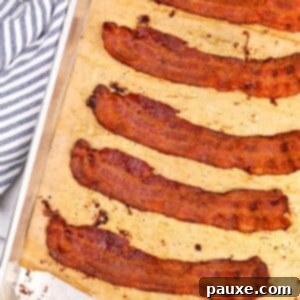
Course: Breakfast, Brunch
Cuisine: American
Prep Time: 5 minutes
Cook Time: 16-22 minutes
Total Time: 21-27 minutes
Servings: 8 slices
Calories: 37 kcal per slice
Author: Dorothy Bigelow
Equipment
- Rimmed Baking Sheet
- Parchment Paper (or aluminum foil)
- Tongs
- Paper towels or cooling rack
Ingredients
- 8 slices regular-cut bacon (adjust quantity for thick or thin cut, or for more servings)
Instructions
- Preheat your oven to 425ºF (218ºC). This temperature is crucial for achieving crispiness.
- Line a rimmed baking sheet with parchment paper (or aluminum foil), ensuring the edges are slightly lifted to contain grease.
- Arrange the bacon slices in a single layer on the prepared baking sheet, making sure there is a small amount of space between each piece. Do not overlap the bacon, as this can lead to uneven cooking and steaming.

- Bake in the preheated oven for 8-10 minutes.
- Carefully remove the baking sheet from the oven. Using tongs or a fork, flip each bacon slice to ensure even browning and crisping on both sides.
- Return the baking sheet to the oven and continue baking for an additional 8-12 minutes, or until the bacon reaches your desired level of crispiness and golden-brown color. Watch closely during these final minutes as bacon can quickly go from perfect to overcooked.

- Once crispy, remove the baking sheet from the oven. Transfer the cooked bacon to a plate lined with paper towels (or a wire cooling rack) to drain off any excess grease. This step helps ensure maximum crispiness.
- If cooking more bacon, repeat the process with any remaining slices, working in batches. For best results, it’s recommended to carefully drain off any accumulated bacon fat from the pan in between batches to prevent smoking and flavor transfer.
Notes
- Storage: Allow cooked bacon to cool completely. Store in an airtight container in the refrigerator for up to 5 days, or freeze for 3-6 months.
- Freezing: For freezing, place cooled bacon in a single layer on a parchment-lined tray and flash freeze until solid. Then transfer to a freezer-safe bag, removing as much air as possible, and label with the date. Reheat from frozen.
- Reheating: For best results, re-crisp reheated bacon. Use a pre-heated skillet (30-60 seconds per side), an air fryer on “reheat” (1-3 minutes), or a microwave in 30-second intervals. Drain on paper towels if desired after reheating.
- Thick-Cut Bacon: Add approximately 2-4 minutes to the total baking time.
- Thin-Cut Bacon: Reduce the total baking time by about 2-4 minutes, watching very closely.
- Less Crispy: If you prefer chewier bacon, remove it from the oven earlier, around 12-16 minutes (for regular cut), as soon as it reaches your desired doneness.
Nutrition (per slice)
Calories: 37kcal | Carbohydrates: 0.1g | Protein: 3g | Fat: 3g | Saturated Fat: 1g | Polyunsaturated Fat: 0.5g | Monounsaturated Fat: 1g | Trans Fat: 0.01g | Cholesterol: 8mg | Sodium: 134mg | Potassium: 40mg | Vitamin A: 3IU | Calcium: 1mg | Iron: 0.1mg
Please note that some of my blog posts may contain affiliate links. If you make a purchase through these links, I may earn a small commission at no additional cost to you. For more information, please see my Disclaimer.

